What Makes a Good Frame?
When most people choose windows, they begin by considering the frame material. They might be predisposed to traditional wood or low-maintenance vinyl. However, according to Nils Petermann at the Efficient Windows Collaborative, the most important factor to consider is the frame’s durability. This is where I’d like to refer you to an independent organization that provides unbiased durability ratings for window frames. Unfortunately, there isn’t one.
You can make educated guesses about durability based on the frame material. But whether it’s wood, vinyl, fiberglass, aluminum, clad, or composite, a well-constructed window lasts longer and performs better than a poorly constructed one regardless of the relative benefits of its frame material.
The best way to get a sense of window quality is to read all the product literature you can get your hands on and to look at actual windows—a lot of them. Go to the big-box store and the local building supply, and open and close the windows on display, paying attention to how the corners are joined, how well the sashes seal, and how rigid the unit is.
On vinyl windows, look for continuous thermally welded corners. Examine the corner cutaway displays of aluminum windows for a continuous thermal break in both frame and sash. On a clad window, the cladding should have well-sealed corners and gaskets to prevent water from getting behind the cladding. Aluminum is an excellent heat conductor, so be sure that aluminum cladding doesn’t contact conditioned interior air at any point.
Another way to sift through the options is to talk to reputable builders and architects in your area. Ask what windows they use and how long they have been using them. They won’t stick with windows that make their clients unhappy.
Thirty years ago, when single-pane windows were the rule rather than the exception, companies looking to improve window performance focused their research on insulating glass. It was the lowest-hanging fruit. They’ve done such a good job that the R-value of insulated glass is good enough to make the window frame the weak link in the thermal chain. That’s one reason why manufacturers list performance data for relatively large windows, say, 4 ft. by 5 ft. (When you’re comparing windows, make sure the performance data are for windows of the same size.) Windows with large areas of glass yield better performance numbers because the frame is a smaller percentage of the window area. Savvy window designers understand this and tweak their windows accordingly for optimal performance. By using strong materials that permit low-profile sills, sashes, and jambs, they minimize the size of
![]()


 To understand and appreciate how a window works,
To understand and appreciate how a window works,
■ you need to know the components that make up a basic window. While there are several types of windows besides the double-hung and casement illustrated here, the terminology used to describe each piece is universal.
Windows need to insulate
Sealed airspaces improve insulation. The more insulating spaces in the glass unit, the better the performance; tripleglazed windows are among the most energy efficient you can buy. Aluminum, vinyl, and fiberglass frames use extruded chambers both for strength and as a thermal break. Filling these cavities with foam provides additional insulation. Solid-wood frames are about as efficient as vinyl.
Window DNA: The NFRC Label by the Numbers
A measure of the insulating value. U-factor is the nonsolar heat flow through all parts of the window (glass, frame, and sash).
A lower number means better insulation and greater performance.


A measure of the amount of visible light that passes through the window. Values range from 0 to 1 (a higher number equals more light). However, most ratings are between 0.3 and 0.8 because they take into account the light blocked by the frame. Choose windows with higher VT to maximize daylight and views.
CoNDENsAHoN RESiSTANCE
A relative scale from 0 to 100 — based on the window’s properties. It predicts the likelihood of condensation, with higher numbers indicating less condensation.
the conductive frame while being sure to incorporate materials that reduce air leakage.
Frame material can also influence how long a window stays airtight. Like most building materials, windows expand and contract with changes in temperature and humidity. When you see a window with moisture between panes, it’s likely that movement between the glass and the sash broke the insulating seal. By choosing stable materials, you can reduce stress on the seal and increase the window’s longevity. Fiberglass expands at the rate of glass, while aluminum and vinyl expand respectively 3 times and 7 times more than glass. Wood moves in response to humidity changes rather than temperature.






Leave a reply